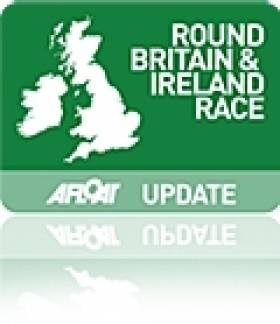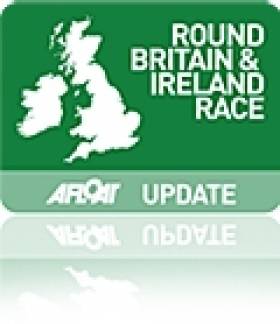Displaying items by tag: Sevenstar Round Britain and Ireland Race
Most of the Fleet Expected Back by Sunday
It has been over 24 hours since any yacht, competing in the Sevenstar Round Britain and Ireland Race finished writes Louay Habib. However a rush is expected for the second half of the day, with three boats expected in the early hours of tomorrow morning and the majority accounted for by Sunday.
There are still 12 yachts racing in the Sevenstar Round Britain and Ireland Race but Keith Gibbs C&C 115, Change of Course pulled into Dingle on the west coast of Ireland in the early hours of this morning with a broken forestay.
The next boat to finish should be Chaz Ivill's Grand Soleil 54, John B who is expected to finish in the early hours of tomorrow morning and claim third place in IRC Zero. Clipper 68, Hull & Humber look to be getting the better of their sistership, Edinburgh Inspiring Capital. At 1400 BST Hull & Humber had 108 miles to go and were averaging eight knots giving them an estimated finish time of 0400 tomorrow.
At 1400 BST, the Army Association's A 40, British Soldier was passed the Lizard with 195 miles to go. Over the last 24 hours, they have stretched out their lead on the water and look likely to take line honours for Class IRC One. Steven Anderson's First 40.7, Encore is 21 miles behind British Soldier but still leads the class after corrected time.
In IRC Two, Harry Heijst owner of S&S 41 Winsome, had a proper birthday celebration on board. With balloons and the satisfaction of opening up a big lead on rivals, Swan 44 Selene, owned by Adrian Lower. At 1400 BST, Winsome is 28 miles ahead of Selene and even further ahead after corrected time. Selene took up a very westerly position yesterday but the move has not paid off. Winsome with Sevenstar's Managing Director, Richard Klabbers on board, is very much the yacht to beat in IRC Two.
Tonnerre Narrowly Misses Out on Round Britain and Ireland Win
At just before 2 a.m. this morning, The British Keelboat Academy's TP52, John Merricks II crossed the Royal Yacht Squadron Line to finish the Sevenstar Round Britain and Ireland Race. The 14 young crew on board should have taken a bow, but instead they were organising packing up the boat and plan to be back competing in the RORC offshore race to Cherbourg on Friday. Completing this tough and challenging yacht race in a boat that was not constructed for that purpose is some achievement and the John Merricks II crew should be highly regarded for their impeccable boat handling.
"This has been and always was going to be the highlight of our season. It is what we have all been building up for," commented skipper, Luke McCarthy." The crew all performed magnificently and have taken a big step-up in terms of their capabilities and skill levels. Beating up the North Sea was very hard on the crew and the boat, but apart from a few bumps and bruises, the crew and the boat are in good shape. We made a few mistakes which cost us, but the important thing is that we have made leaps and bounds as a crew and we intend to go on from here. I have no doubt that some of the crew will go on to compete at the highest level in offshore racing and I would not be surprised to see some taking part in the Volvo Ocean Race next year."
John Merricks II is second in IRC Super Zero and currently fourth in IRC overall. Crew members Sally Olsen from Devon and Becky Scott from Scotland are the first two girls to complete thisyears race.
Less than two hours later than John Merricks II, Piet Vroon's Ker 46, Tonnerre de Breskens came through the line at pace under spinnaker. In a great show of sportsmanship, John Merricks II cheered Tonnerre de Breskens in. On board were many of their friends and seven of the 11 crew racing Tonnerre de Breskens are under 28 years of age. On the other hand, Piet Vroon is now in his 81st year. Vroon is a previous winner of this race and a veteran of more than 25 Fastnet Races as well as countless RORC offshore races. He has more experience in yacht racing than anyone in the entire fleet. Dockside, Piet Vroon commented:
"Obviously it is disappointing not to win, but we can do nothing about the wind, no-one can. It is has been a fantastic race. I will always remember flying down the west coast of Ireland under spinnaker for a whole day and a whole night. We had our problems, just like everyone else did, but when we had no gas to cook with, we still had food and cold coffee. We didn't go hungry and when the motion of the boat was so bad that we couldn't stand up, we still did our jobs. Everybody has problems, they are not the concern, solving them is. This race is a long one, but once you have spent a few days at sea, a few more doesn't matter so much. I have to say, when we were passing Aberdeen beating up the North Sea, I did think about the nice office I have there and the coffee machine! But, I can only remember retiring from two races; once for my mother's funeral and the second, a Fastnet race when we were dismasted."
Piet Vroon is obviously a man who doesn't give up.
This race has been full of record breakers and the next yacht to finish the Sevenstar Round Britain and Ireland Race should be Tony Lawson's Class 40, Concise skippered by Tom Gall. At 1000 BST, Concise were 114 miles out and expected to finish tomorrow morning. They are currently experiencing very unusual light easterly winds but there will be a big celebration for the young crew. They should be well inside, Michel Kleinjans' Roaring Forty, whose record time of 11 Days 12 hours 26 minutes and 12 seconds has stood for six years.
At 1000 BST, Eike Holst's Andrews 56, Norddeutsche Vermögen Hamburg had 151 miles to go. The German yacht should finish tomorrow assuming that the light winds hold out. As a result of the high-pressure system that is situated over central England, the remainder of the fleet is a substantial distance further back on the race course.
In IRC One, Steven Anderson's First 40.7 Encore, has a substantial lead. In IRC Two, Winsome still hold the advantage over close rival Selene. However Selene has made a move to the west of the rhumb line which will be interesting to see how they fare. It will be a long haul for the boats at the back of the fleet. At 1000 BST, The Army Sailing Association's A 40, British Soldier was off the Tearaght Islands on the stunningly beautiful south west coast of Ireland. British Soldier had 457 miles to go but they obviously haven't lost their sense of humour. As skipper, Tim Hill explains in his blog:
"Life remains on board relatively sane. No major concerns with regards to rations, gas or water, although some interesting combinations are beginning to appear which weren't listed on the original victualling plan. We're out of Tabasco (although Paul, the 1st Mate keeps producing his own reserve which looks decidedly like our missing spare bottle); coffee has been rationed to the over 28s (that's the skipper and 1st mate only) and if we don't get in before Friday, then it's Vesta curry for breakfast, lunch and supper on Sat and Sun - nice!
Jonny Malbon's IMOCA 60 Artemis Ocean Racing is still leading the Sevenstar Round Britain & Ireland overall under IRC.
Leopard Seeks Round Britain and Ireland Record
ICAP Leopard's crew will be made up of the usual collection of established ocean racers, including leading solo round the world sailor Sam Davies, who currently holds the monohull course record of six days, 11 hours, 30 minutes and 53 seconds. Sam broke the course record with fellow round the world sailor Dee Caffari aboard the IMOCA 60 Aviva in 2009. This year sees a highly competitive fleet, including Telefonica Azu's VO70 and the IMOCA 60 Artemis Ocean Racing, meaning the crew will need to push the boat hard to ensure line honours.
Mike Slade, commented: "Once again we have a great team onboard for this classic offshore race. Sailing around Britain and Ireland produces some of the most complex weather systems in the northern hemisphere, so we'll have to be on our toes to ensure we give ourselves a chance at beating the record."
Sam Davies, revered round the world sailor, said: "As current course record holder and having sailed the Sevenstar Round Britain and Ireland Race a number of times before, I cannot wait to get started. The nature of sailing around an island means that the weather systems are not consistent in direction and therefore produce very changeable weather. This makes it all the more challenging and one of the most interesting offshore races around."
Starting on the Royal Yacht Squadron line in the Solent, ICAP Leopard will head out of the Solent and along the South Coast, past Bishop Rock before heading north into the Celtic Sea. Leaving Ireland to starboard, the journey will then see the boat begin a 230 mile open water leg past St Kilda and the Flannan Isles. Through changeable and challenging weather conditions, the boat will continue around the Outer Hebridies, past Muckle Flugga and then down the East of the Britain. Having dodged the busy shipping lanes and oil rigs in the North Sea, the crew will undertake a final push past Dover finishing at the Royal Yacht Squadron line.
http://www.leopard3.com and follow the link to the Round Great Britain & Ireland Race pages.































































